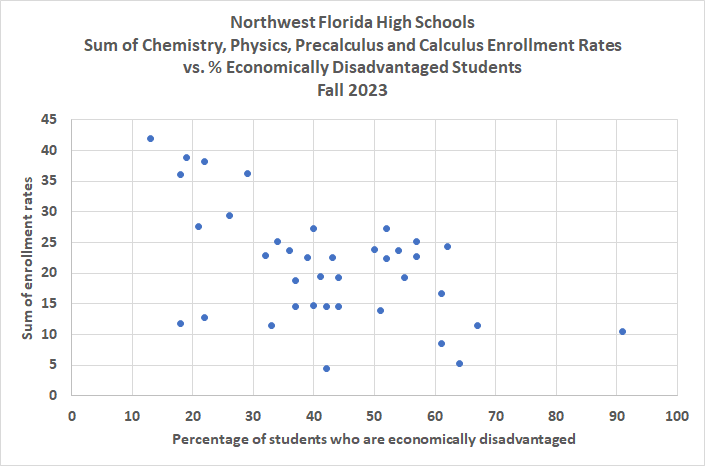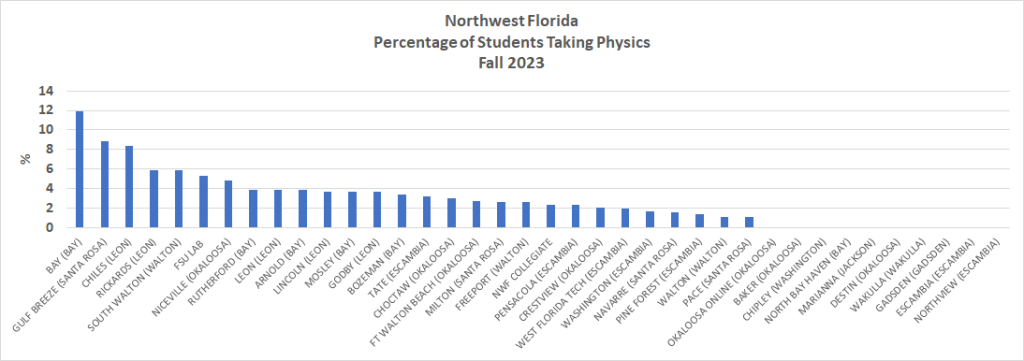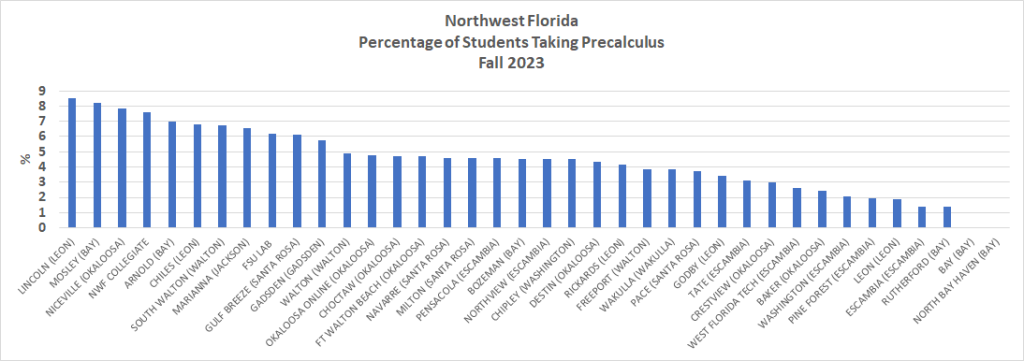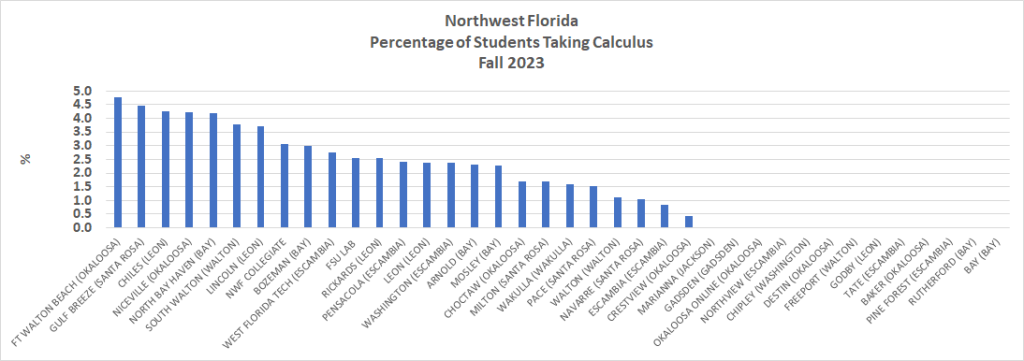Course enrollment data released by the Florida Department of Education every year show that students who are classified by the state as economically disadvantaged are much less likely to take Advanced Placement courses in chemistry, physics and calculus (and this year precalculus) than students who are not economically disadvantaged.
That result suggests this question: Do high schools with fewer economically disadvantaged students always have higher course enrollment rates in chemistry, physics, precalculus and calculus?
Here I will explore that issue by looking at course enrollment data for 38 public high schools in Northwest Florida – a region bounded by Leon and Wakulla Counties on the east and extending all the way to Escambia County, which is bounded on the north and west by Alabama.
[Spoiler Alert: The answer to the question is “no”.]
I started by using the FLDOE’s Fall 2023 school-level course enrollment data to determine course enrollment rates (the percentages of a school’s students taking a subject) for chemistry, physics, precalculus and calculus. The course enrollment data include dual enrollment as well as regular high school level courses. The first plot below ranks the 38 public high schools I examined by the sum of the course enrollment rates for the four subjects. The schools I chose generally have 100 or more students in each grade. The five schools with the highest enrollment rate sums include two from Leon County (Chiles and Lincoln), one from Santa Rosa County (Gulf Breeze), one from Okaloosa County (Niceville) and one collegiate school, this one affiliated with Northwest Florida State College in Okaloosa County.
The FLDOE classifies students according to economic status as either economically disadvantaged or non-economically disadvantaged. The criteria that the FLDOE uses for this classification divides the state’s public school students almost exactly in half, so that 50% are classified as economically disadvantaged. The top five schools in the course enrollment rate ranking all have relatively small percentages of students classified as economically disadvantaged. At Chiles, 13% are economically disadvantaged. At Northwest Florida Collegiate, Gulf Breeze, Lincoln and Niceville, the percentages are 19%, 22%, 29% and 18%, respectively.
In the second graph below, I plot the course enrollment rate sum against the percentage of students who are economically disadvantaged. That is, the schools on the left side of the graph have more affluent student bodies, and the schools on the right side have student bodies that are much more economically challenged. By far the most economically challenged school among the 38 I examined is Gadsden County High School, where 91% of the students are classified as economically disadvantaged. Not surprisingly, they are ranked fourth from the bottom by the course enrollment rate sum.
The economic disadvantage plot shows the correlation between enrollment in upper level math and science courses and economic disadvantage that is enshrined in conventional wisdom (which in this case is correct). But even for a given percentage of economic disadvantage, there can be quite a spread in the summed course enrollment rates. I’ll start with the good news. Leon County’s Godby High School has a high economic disadvantage percentage (62%) but also a relatively high course enrollment rate sum (24.4). That not only places Godby far ahead of other schools with economic disadvantage percentages in the 60’s (Rutherford, Walton, Pine Forest and Escambia) but also far ahead of two schools with quite affluent student bodies (North Bay Haven and Destin, at which 22% and 18% of students are economically disadvantaged, respectively).
It would be easy enough for me to wave my hand around and speculate that school culture is the secret sauce that drives even economically disadvantaged high school students into the upper level math and science courses they need to be prepared to succeed in college STEM majors, but the anecdotes I’ve collected over the years are not data. The very best I can do here is to acknowledge the influence of student body economic status on enrollment rates in chemistry, physics, precalculus and calculus, but to note that there are other strong influences on student course enrollment patterns and, therefore, on the STEM career opportunities open to students. We should all focus on that latter set of influences.






